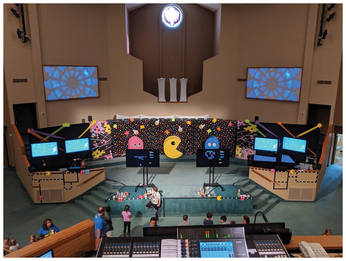Pyro – Networking made simple
One for All

© Lead Image © FernandoCortes, 123RF.com
Pyro allows multiple hardware devices to interact as if they are all on a local machine by hiding the networking.
Several of my projects have required multiple Raspberry Pis working in tandem to accomplish an ultimate goal, such as driving multiple independent displays or integrating a device with a dedicated controlling computer. Sometimes the setup had unique hardware (e.g., sensors); other times distance made it easier to use a remote system and WiFi rather than a lot of cabling. Although you can choose from many approaches to distributed technology, here, I'll focus on the Python remote objects (Pyro) library.
My most recent project that fell in this category was a set of scoreboards for my church's Vacation Bible School. I integrated four large LCD TVs into the set design (Figure 1) and dedicated a Raspberry Pi to each one. Also, I wanted the ability to update each team's score in real time from a centralized console. To accomplish this, I wrote the code for the scoreboards and their controller in Python and communicated between the different screens with Pyro [1].

[...]
Buy this article as PDF
(incl. VAT)
Buy Linux Magazine
Subscribe to our Linux Newsletters
Find Linux and Open Source Jobs
Subscribe to our ADMIN Newsletters
Support Our Work
Linux Magazine content is made possible with support from readers like you. Please consider contributing when you’ve found an article to be beneficial.

News
-
Mozilla Plans to AI-ify Firefox
With a new CEO in control, Mozilla is doubling down on a strategy of trust, all the while leaning into AI.
-
Gnome Says No to AI-Generated Extensions
If you're a developer wanting to create a new Gnome extension, you'd best set aside that AI code generator, because the extension team will have none of that.
-
Parrot OS Switches to KDE Plasma Desktop
Yet another distro is making the move to the KDE Plasma desktop.
-
TUXEDO Announces Gemini 17
TUXEDO Computers has released the fourth generation of its Gemini laptop with plenty of updates.
-
Two New Distros Adopt Enlightenment
MX Moksha and AV Linux 25 join ranks with Bodhi Linux and embrace the Enlightenment desktop.
-
Solus Linux 4.8 Removes Python 2
Solus Linux 4.8 has been released with the latest Linux kernel, updated desktops, and a key removal.
-
Zorin OS 18 Hits over a Million Downloads
If you doubt Linux isn't gaining popularity, you only have to look at Zorin OS's download numbers.
-
TUXEDO Computers Scraps Snapdragon X1E-Based Laptop
Due to issues with a Snapdragon CPU, TUXEDO Computers has cancelled its plans to release a laptop based on this elite hardware.
-
Debian Unleashes Debian Libre Live
Debian Libre Live keeps your machine free of proprietary software.
-
Valve Announces Pending Release of Steam Machine
Shout it to the heavens: Steam Machine, powered by Linux, is set to arrive in 2026.

